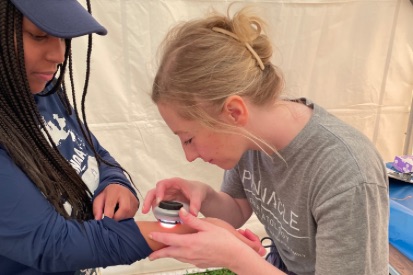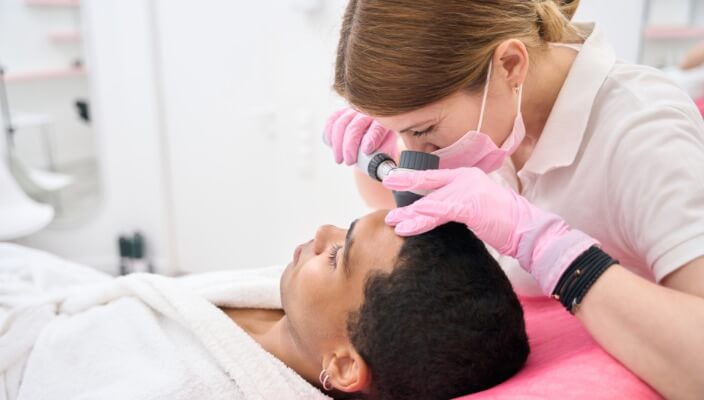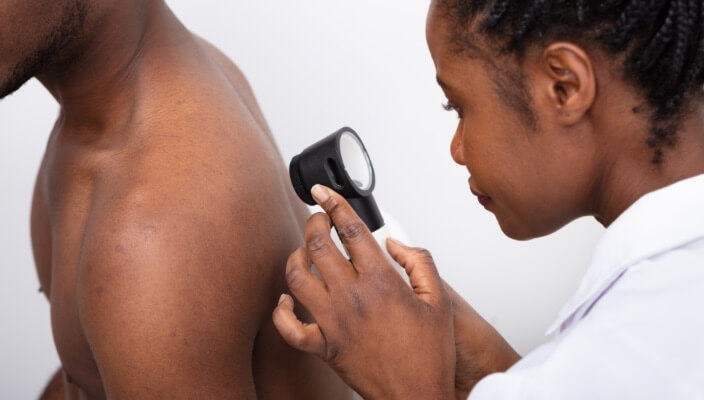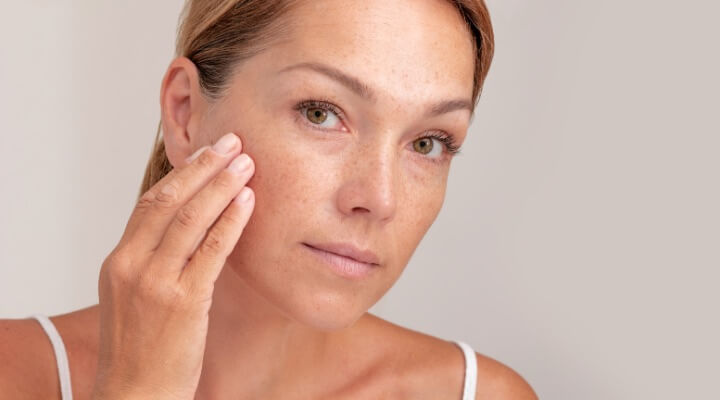Skin Self Exam
Spot Skin Cancer Early with Monthly Skin Self-Exams

Skin cancer is the most common cancer in the U.S., affecting one in five Americans. When detected early, the five-year survival rate for melanoma, the most serious skin cancer, is 99%.
Skin cancer is cancer that you can SEE. The best way to detect skin cancer early is by regular self-examinations of your skin, ideally once a month. Through monthly skin self-exams, you will come to know your skin and be able to notice changes in freckles, moles or other spots.
Self-exams should not replace regular visits with your dermatology provider; they aid in the early recognition of skin changes between your annual Total Body Skin Exam visits.
Items needed for your self-exam
- Full-length mirror in a well-lit room
- Hand mirror to view areas that are difficult to see
- Nail polish remover to remove polish before checking your nails
- Cell phone camera, notebook or Mole Map to document for your dermatology provider any areas of concern
- A partner or friend to help you examine hard-to-reach places, such as your back and scalp
What you should look for
- New, expanding, or changing growth, spot or bump
- Open sore, scab or pimple that bleeds or doesn’t heal after several weeks
- Rough or scaly red patch, which may crust or bleed
- Wart-like growth
- Spot or mole that exhibits any of the following ABCDEs:
- Asymmetry: one side appears different than the other
- Border: irregular, scalloped or poorly defined border
- Color: multicolored, with different shades of tan, brown, black, white, red or blue
- Diameter: larger than 6 mm (the size of a standard pencil eraser)
- Evolving: changes in size, shape or color
How to examine your skin
Overview: stand in front of a full-length mirror and examine your front and back as best that you can. Next, look at your right side, then your left side with your arms raised.
Face, neck and scalp: carefully examine your face, ears, and the front of your neck. Use a hand mirror to check the back of your ears, neck and scalp. A comb or hairdryer can help part your hair.
Torso: continue facing the full-length mirror and check your chest and abdomen. Women should also inspect underneath their breasts. Use the hand mirror if you need to see an area closer.
Hands and arms: check both sides of your hands, including between each finger and under your nails. Inspect your wrists, all sides of your lower and upper arms, and your underarms.
Back and buttocks: with your back to the full-length mirror, check your back, buttocks and genitals using the help of a hand mirror. It is ideal to ask a loved one to check these areas for you, as they can be hard to view.
Legs and feet: sit on a chair or stool and examine the front of each leg; use a hand mirror to visualize your calves and the back of your thighs. Check between your toes, underneath each nail and the bottoms of your feet.
As you examine your skin, note areas that have changed or are of concern, and keep a log of your monthly exams. Use the American Academy of Dermatology Mole Map to document your findings and share them with your dermatology provider. It is also helpful to photograph the area with your cell phone.
Watch: The Importance of Total Body Skin Exams Explained
If you find something suspicious
If you see anything that concerns you, have it checked by a Pinnacle Dermatology provider, even if it’s not time for your annual skin exam. It’s best to err on caution and have the area evaluated by one of our professionals for peace of mind. Call (877) 857-2984 to schedule your appointment.
Self-exams should not replace regular visits with your dermatology provider; they aid in the early recognition of skin changes between your annual Total Body Skin Exam visits. Our board-certified dermatologists and advanced practice providers screen, diagnose, and treat all disorders of the skin, including skin cancer. We look forward to seeing you.

Schedule Your Skin Check at Pinnacle
Find a location nearest you and schedule your TBSE online today.
Featured Products
Check your local office for current stock!
Check your local office for current stock!
Featured Blogs

- Skin Cancer
- Skin Exams
- Sun Safety
When it comes to skin cancer detection, the saying "better safe than sorry" couldn't be more appropriate.
Read More
- Skin Cancer
- Skin Exams
Uncover crucial facts about skin cancer prevention, dispel myths, and stress the significance of sun protection and regular skin checks, all underlined by compelling statistics.
Read More
- Skin Cancer
- Skin Exams
Total Body Skin Exams (TBSEs) are crucial for healthy skin. Learn more about the importance of TBSEs and skin cancer detection.
Read More


